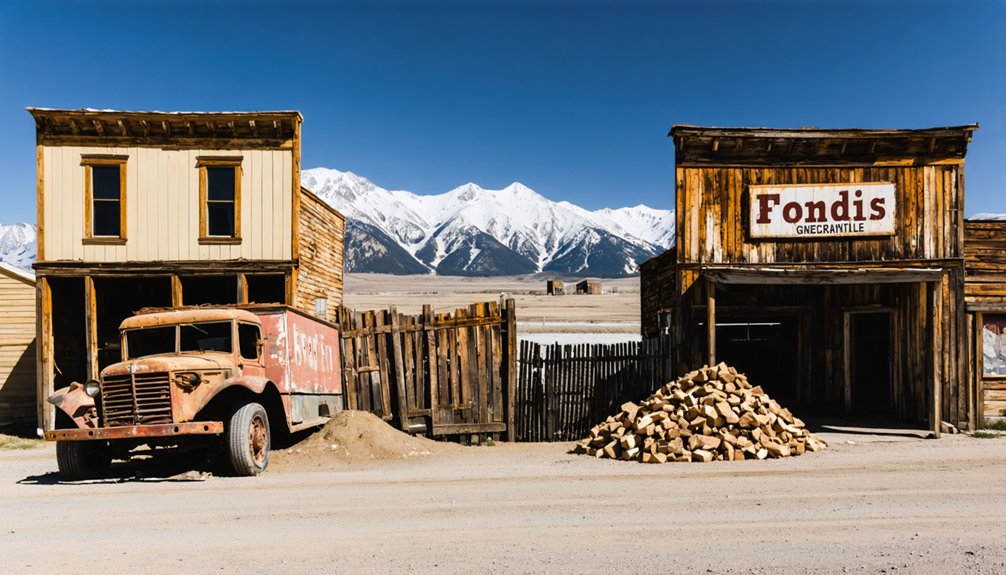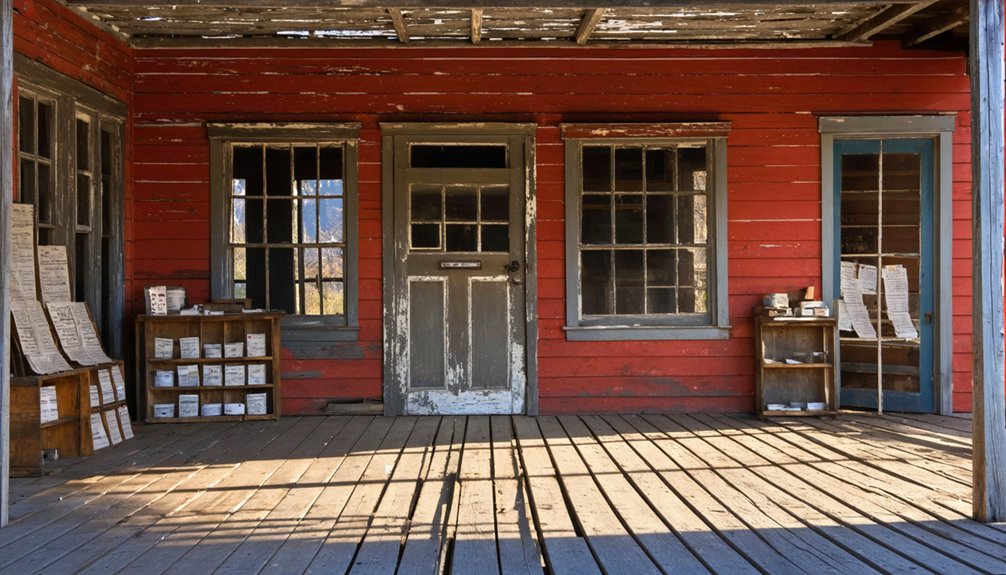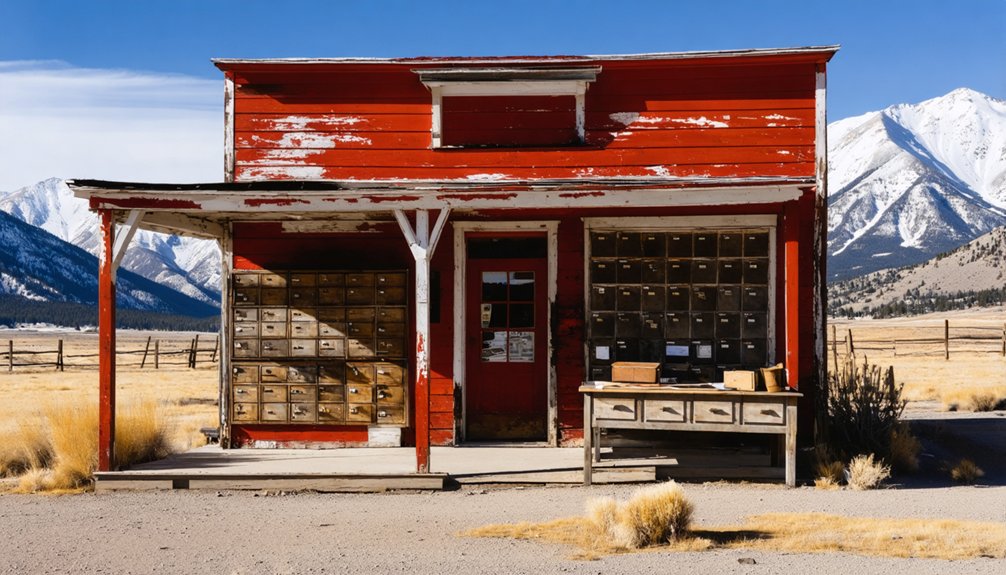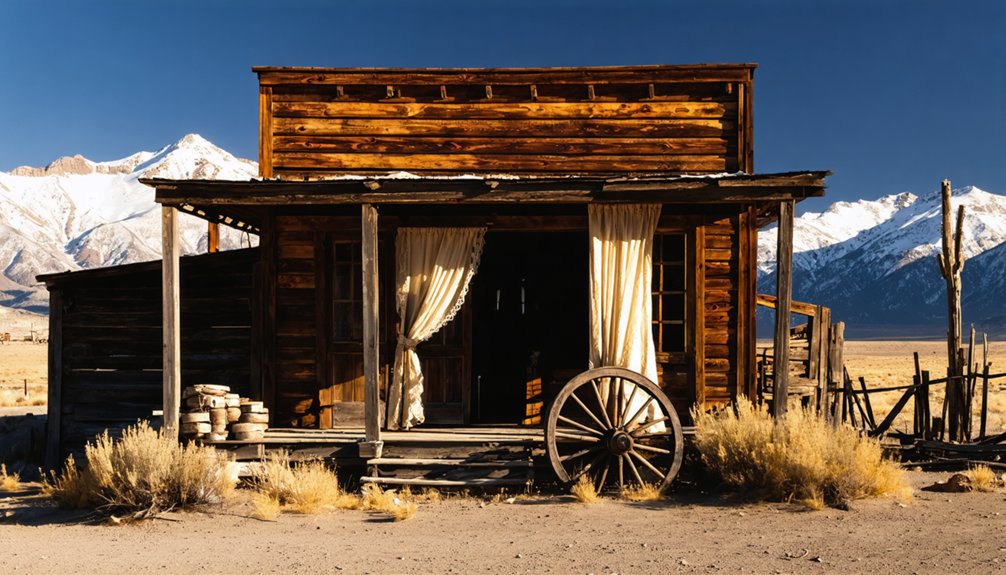Fondis, Colorado emerged in the late 1890s as a small agricultural community centered around Harper’s General Store and Will Conarroe’s cheese factory. You’ll find its Italian-named origins reflected in the settlement that grew to about 40 residents by 1900. The town functioned without electricity, relying on kerosene lamps until its gradual decline. After the post office closed in 1954, Fondis faded into history, its wooden structures slowly surrendering to harsh plains elements.
Key Takeaways
- Fondis was established in the late 1890s as an agricultural community with around 40 residents by 1900.
- The town centered around Harper’s General Store, blacksmith shops, a hotel, and Will Conarroe’s cheese factory.
- Fondis likely derived its name from Fondi, Italy, reflecting the Italian-American heritage of early settlers.
- The closure of the Fondis post office in 1954 marked the official end of the community.
- Wooden structures in Fondis face deterioration from harsh environmental conditions, endangering this historical plains settlement.
The Rise and Fall of an Eastern Colorado Settlement
While many Colorado ghost towns emerged from the boom-and-bust cycles of mining, Fondis tells a different story of rural America’s shifting landscapes.
You’ll find its origins in the late 1890s, when the post office opened with Ella Cox serving as postmaster. By 1900, about 40 residents called this eastern plains settlement home.
Fondis emerged quietly in the 1890s—a humble plains settlement with Ella Cox’s post office at its heart.
The town’s brief prosperity centered around Harper’s General Store, blacksmith shops, and a hotel with unexpected Italian influence. Will Conarroe’s cheese factory produced 250 pounds daily, reflecting the cultural heritage of early settlers. The cultural significance of Fondis extended beyond its economic activities, shaping community identity. Like many other rural communities, Fondis gradually emptied as people migrated from farms to larger urban centers.
The Fondis Herald chronicled local life for just ten weeks in 1902.
Unlike mining boomtowns, Fondis declined slowly through rural depopulation, finally closing its post office in 1954—marking the end of a community that time simply passed by.
Tracing the Italian Connection in Fondis’ Name Origins
Beyond the weathered buildings that remain, Fondis carries a linguistic echo of the Old World in its very name.
You’re witnessing the legacy of Italian heritage in this eastern Colorado ghost town, which likely derives from Fondi, an ancient settlement in Italy’s Lazio region.
When Italian-American settlers established communities across the frontier, they often named their new homes after their origins—creating tangible connections to the lands they’d left behind.
Fondis represents a classic case of linguistic adaptation, with the subtle “-is” suffix representing an Americanization of the original Italian toponym. Like the Marozzo family that maintained their fencing traditions for generations, these settlers preserved cultural connections while establishing new roots in America. Similar to how Craco experienced significant population decline due to environmental challenges, many frontier towns like Fondis saw their communities diminish as economic opportunities shifted elsewhere.
The town’s naming reflects a deeper immigrant experience—postmasters and early settlers with Italian roots maintained cultural identity while adapting to their new American context, embedding their heritage in Colorado’s very geography.
Daily Life in Early 20th Century Fondis
Despite its modest size of just 40 residents at the turn of the 20th century, Fondis pulsed with the rhythms of frontier life that defined countless small settlements across Colorado.
Your daily routines would have revolved around Harper’s General Store and the bustling cheese factory producing 250 pounds daily—the economic heartbeat of town.
You’d recognize everyone by name, strengthening community ties through necessities rather than convenience.
After arranging mail with postmaster Ella Cox, you might’ve shared news at the Fondis Hotel while Will Conarroe tended to travelers passing through.
No electricity or indoor plumbing meant simpler living—kerosene lamps illuminated evenings spent in conversation or card games, much like the limited lighting miners relied on in Colorado’s dangerous mining tunnels.
When the Fondis Herald circulated for its brief 10-week run in 1902, you’d have savored each local story.
The Cheese Factory: Will Conarroe’s Commercial Legacy
You’d find Will Conarroe’s cheese factory producing an impressive 250 pounds of cheese daily around 1901, making it a significant commercial enterprise for such a small settlement.
This substantial output required a steady supply of milk from local dairy farmers, transforming Fondis into a regional agricultural hub during its brief economic heyday. The success of dairy operations has historically depended on proximity to processing facilities to ensure milk remains fresh.
Conarroe’s operation, established alongside his hotel and general store, exemplified how early Colorado entrepreneurs leveraged local resources to create economic ecosystems that supported entire communities. His son Lawrence Conarroe would later continue the family’s connection to the area, working for the El Paso County Road Department for 35 years after the family homesteaded at Fondis.
Daily Cheese Production
While Fondis’ commercial landscape offered limited opportunities for industry, Will Conarroe’s cheese factory stood as a symbol of rural entrepreneurship in early 20th-century Colorado.
The operation hummed with activity daily, turning out an impressive 250 pounds of cheese—likely common varieties such as cheddar or farmer’s cheese using traditional production methods.
You’d have witnessed a bustling center of commerce if you’d visited in the early 1900s. The factory’s substantial output made Fondis a regional dairy supplier, creating jobs and stimulating the local economy beyond its agricultural roots. The success of this operation foreshadowed how dairy cow populations would later reach unprecedented levels throughout northern Colorado. Modern factories like Leprino Foods now process over 5 million pounds of milk daily in the region.
Conarroe’s dual ownership of both the cheese factory and Fondis Hotel exemplified the pioneering spirit that defined these frontier communities. His dairy business transformed raw materials from surrounding farms into marketable goods that connected Fondis to wider commercial networks.
Agricultural Economic Hub
The heart of Fondis’ agricultural economy beat strongest at Will Conarroe’s cheese factory, a commercial enterprise that transformed the small community into a regional dairy hub after 1904.
When the Conarroes purchased both the factory and hotel, they established a powerful economic engine that influenced community dynamics throughout the area.
The factory wasn’t just a business—it created jobs, established local supply chains with nearby farms, and marketed goods beyond Fondis’ borders.
This multi-use commercial site, combined with Harper’s General Store and local blacksmiths, created an interconnected economic ecosystem rare for communities of just 40 residents.
You can imagine how this agricultural venture brought economic sustainability to families who might otherwise have struggled in rural Colorado, turning Fondis briefly into a self-sufficient outpost with its own newspaper and commercial identity.
The Fondis Herald: Documenting a Community’s Brief History

As you stroll through Fondis’s forgotten streets, you’ll find faint echoes of the town’s voice in The Fondis Herald, a ten-week wonder published by Fred A. Coan in 1902.
Weekly issues emerged despite the constant challenges of operating a press in a frontier town of merely forty souls—ink shortages, mechanical failures, and limited advertising revenue threatened each edition.
The Herald’s brief existence mirrors the fleeting nature of Fondis itself, capturing weekly snapshots of commerce, social gatherings, and community aspirations before both paper and town faded into Colorado’s historical landscape. Like Dearfield, this once-promising settlement transitioned from a vibrant community to a ghost town due to economic hardships.
Weekly News Coverage
During Fondis’ brief heyday in 1902, a remarkable community institution emerged in the form of The Fondis Herald, a weekly newspaper that chronicled the lives and activities of the town’s modest population of 40 residents.
Fred A. Coan ran this essential communication tool for approximately ten weeks, covering local events from the cheese factory’s impressive 250-pound daily production to updates from the blacksmith shops and hotel.
You’d have found the Herald serving as more than mere news—it fostered community identity in this unincorporated settlement.
As you turned its pages, you’d glimpse a town determined to document its existence despite challenging economic conditions.
Though short-lived, this publication reflected Fondis at its peak, preserving precious insights into rural Colorado life before the inevitable decline that would eventually transform the thriving village into the ghost town you’d recognize today.
Publishing Challenges
Subscriber struggles plagued the Herald from the start.
With such a limited population base and minimal advertising revenue from the small shops and cheese factory, sustained publishing became economically impossible.
Distribution challenges compounded these issues—poor roads and limited transportation options restricted the paper’s reach beyond Fondis proper.
The Herald’s brief existence reflects the harsh realities of frontier publishing, where ambitious literary ventures often succumbed to practical constraints.
What Remains: Visiting Fondis Today
Hidden deep within the rugged San Juan Mountains at an elevation exceeding 10,000 feet, Fondis stands as a tribute to Colorado’s bygone mining era.
When you venture here for Fondis exploration, you’ll discover a raw, unfiltered glimpse into the past that few ghost towns still offer.
What you’ll encounter:
- Weathered log cabins with collapsing roofs and walls, some partially stabilized through ghost town preservation efforts
- A small, overgrown cemetery with readable headstones telling silent stories of frontier hardship
- Scattered mine tailings and foundations reclaimed by alpine vegetation
- Breathtaking mountain vistas that remind you why settlers braved such harsh conditions
The 20-mile journey from Lake City requires high-clearance vehicles and adventurous spirits, but rewards you with solitude rarely found at more accessible historic sites.
Harper’s General Store and Local Commerce

Standing at the center of Fondis’s economic life, Harper’s General Store served as a frontier commerce hub where George Conarroe offered everything from canned foods to farming tools around 1900.
You’ll find the store’s legacy intertwined with Tom Harper’s construction work and the town’s agricultural roots, particularly Will Conarroe’s nearby cheese factory that produced 250 pounds daily.
The establishment’s multifunctional role—connecting local farmers with manufactured goods while potentially housing postal services—represents a perfectly preserved snapshot of rural Colorado’s retail history.
Frontier Commerce Hub
Five thriving businesses formed the commercial heart of Fondis, with Harper’s General Store standing as the centerpiece of local commerce.
George Conarroe’s establishment supplied essential goods to settlers, serving as the backbone of frontier trade. Will Conarroe contributed notably to the local economy with his hotel and cheese factory, producing an impressive 250 pounds of cheese daily.
You’d find a self-sufficient community where:
- Harper’s General Store stocked everything from food to tools
- Two blacksmith shops maintained crucial equipment and transportation
- The Fondis Hotel welcomed travelers passing through
- A cheese factory and brief newspaper operation rounded out commercial activities
These enterprises clustered together, creating a bustling hub that exemplified the independent spirit of Colorado’s frontier settlements, where commerce flowed freely among residents and visitors alike.
Retail History Preserved
At the commercial heart of Fondis stood Harper’s General Store, a monument to frontier retail that captured the community’s economic spirit. Operated by George Conarroe around 1900, this establishment served as the nucleus of rural trade, offering everything from essential foodstuffs to farming implements.
Unlike today’s specialized shopping, you’d find only one variety of each product—a reflection of simpler times when consumer choice yielded to necessity. The store strengthened community bonds as residents gathered to exchange news while purchasing supplies.
Nearby, complementary businesses like the blacksmith shop and Will Conarroe’s cheese production (250 pounds daily) created a diverse local economy.
Though Fondis has fallen silent, with no modern commercial activity remaining, the legacy of Harper’s endures as a reminder of how general stores once connected isolated communities to the wider world.
Comparing Fondis to Other Colorado Ghost Towns
Colorado’s ghost towns tell vastly different stories of boom and bust, with Fondis standing as a unique example among its more famous counterparts. In any ghost town comparison, Fondis reveals different ghost town dynamics than the typical Colorado narrative.
Unlike the dramatic tales of mining towns, Fondis offers a glimpse into rural America’s quieter decline:
- Size & Economy – With just 40 residents at its peak versus thousands in mining towns, Fondis maintained a diversified agricultural economy while others lived and died by mineral extraction.
- Abandonment Pattern – Fondis faded gradually until its 1954 post office closure, avoiding the sudden crashes that decimated mining settlements after the 1893 silver panic.
- Physical Remains – Few structures survive, unlike well-preserved towns like St. Elmo.
- Historical Significance – Represents rural commercial life rather than the boom-and-bust mining cycle.
The Post Office Era: 1895-1954

The establishment of Fondis’ post office in 1895 marked the beginning of a sixty-year period that would define the town’s most stable era.
You’d have found this small outpost serving as the lifeblood of rural connectivity for scattered homesteaders across the eastern Colorado plains. The post office wasn’t merely a place for postal communication—it functioned as the town’s social hub where residents gathered to exchange news and maintain connections with the outside world.
Typically housed in a corner of the general store, Fondis’ postal services depended on local postmasters who knew every family by name.
When operations ceased in 1954, it signaled more than just the end of mail delivery; it marked the beginning of Fondis’ shift from thriving community to the ghost town you’ll find traces of today.
Preservation Challenges for Plains Ghost Towns
Unlike their mountain counterparts that nestle protectively amid terrain barriers, plains ghost towns like Fondis face uniquely brutal preservation challenges.
Wooden structures splinter under relentless winds and temperature extremes, while funding remains scarce for proper preservation techniques.
You’ll find these sites particularly vulnerable:
- Original buildings standing exposed to harsh elements without natural windbreaks
- Wooden structures suffering from decades of drought-weakened foundations
- Historic sites representing underrepresented narratives like Dearfield’s African American homesteading
- Remote locations with fragmented ownership complicating preservation efforts
Community involvement often becomes the last defense against complete loss, with descendants and grassroots organizations working tirelessly to save these physical connections to our past.
Without significant intervention, these tangible links to plains history will inevitably vanish.
Frequently Asked Questions
Are There Any Descendants of Fondis Residents Still in Elbert County?
Based on Fondis genealogy research and Elbert County history, you won’t find documented descendants still living there. Records show the settlement dispersed by mid-century, leaving no traceable lineages in today’s county population.
What Natural Disasters or Weather Events Affected Fondis Historically?
Like pioneers battling frontier challenges, Fondis residents endured punishing drought cycles, destructive tornadoes, and devastating South Platte River floods causing significant flood damage. Fire hazards increased during dry spells, threatening what little remained.
Were Any Notable Films or Photographs Taken in Fondis?
You won’t find any notable films in Fondis’ film history. Its photography legacy consists solely of amateur snapshots and local historical collections—no professional projects ever documented this forgotten freedom of the frontier.
Did Fondis Have a School or Church for Residents?
You’d find no evidence of formal Fondis education or religion establishments. Historical records show this small frontier town, with just 40 residents, prioritized commerce over institutional services like schools or churches.
What Wildlife or Ecological Features Characterize the Fondis Area Today?
You’ll find a rich wildlife diversity surrounding Fondis today, with mule deer, elk, bears, and migratory birds thriving amidst alpine meadows and recovering forests—nature’s triumph in ecological preservation after mining’s impact.
References
- https://www.wikiwand.com/en/articles/Fondis
- https://history.weld.gov/County-150/Weld-County-Towns/Ghost-Towns-in-Weld-County
- https://kids.kiddle.co/List_of_ghost_towns_in_Colorado
- https://www.youtube.com/watch?v=CCXuJJiQDfA
- https://www.colorado.com/articles/colorado-ghost-towns
- https://en.wikipedia.org/wiki/List_of_ghost_towns_in_Colorado
- https://expeditionportal.com/forum/threads/elbert-county-co.214122/
- https://dominicsagar.com/fondis-colorado/
- https://www.youtube.com/watch?v=J8dR9D3pJrs
- https://www.coloradolifemagazine.com/printpage/post/index/id/172



